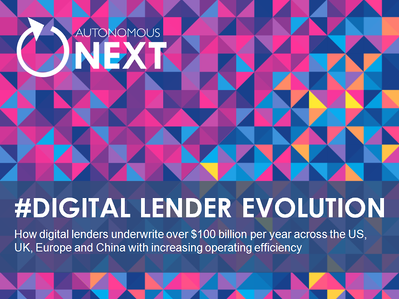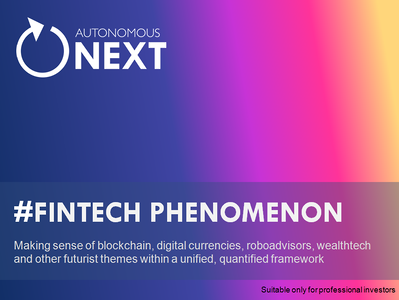Building a Fintech Research Practice
Between 2016 and 2019, much of my focus was on creating a high-end thought leadership and analysis practice. I joined Autonomous Research, an equity research firm focused specifically on covering public financial incumbents, which allowed for access to investors, large company operators, and deep fundamental data sets across the industry. Inspired by the journeys of Mary Meeker and Brett King into the spotlight based on their insights about technology and capital, I designed and articulated a new brand proposition from Autonomous to focus on what is coming next.
It all starts with mission and brand identity. Most finance is grey, blue and beige. Autonomous had a sliver of magenta in its marketing materials, and thus the new identity was born. Bold, pink Instagram-like hues were combined with McKinsey-style strategic analysis and heavy spreadsheet-based data insights. As an entrepreneur, you often look at your space and ask whether there are any competitors. If there is nobody like you, that means either (1) others have tried and are dead, or (2) you're onto something real. In our case, the personalities of anarchist technologists and conservative bankers are too far apart. Building a resource that both of them could respect was going to be an interesting, rigorous challenge.
Futurist Themes in Finance
There were several recurring questions that investors and operators asked about the industry. What will happen when Apple launches a credit card? They have. What will happen when Amazon starts lending? They have. What will the world look like if Facebook does payments? They have. Questions like this were the starting point for our work in Fintech Phenomenon and Future Vision decks, linked below. In those analyses, I answered the question of how digitization is impacting the industry, who will win between the banks, tech firms and fintech startups. Short answer -- revenue collapse of 50%, remainder of revenues is digital, and the winners are investors into R&D while the long tails gets commoditized. This work covered and sized many initial digitalthemes across the front, middle and back office in banking, investment management and insurance. From roboadvisors, neobanks and digital lenders, to insurtech, paytech and regtech, this was a broad and important start. But it was just the beginning.
In addition to regular automation of taking human processes and turning them into machine processes, we saw an emergence of various frontier technologies that would allow tech firms to build new platforms. New platforms imply new user aggregation, pull-based rather than push-based value chains, and billions in venture capital. Such frontiers today are artificial intelligence, blockchain and crypto assets, mixed reality, and the Internet of Things. We also saw that geography played a major role. First, global jurisdictions could be gamed for international token launches. Singapore and Switzerland offered a different version of the world than the United States or India. Regulators and their view on innovation matter. Second, mobile software in China showed an entirely different approach to creating attention platforms, far broader in scope than those of the West. Finance, media and gaming overlapped in single, government-watched, behemoth offerings. There was much to learn.
I am especially proud of our work on Initial Coin Offerings (Crypto Utopia, Token Mania), Machine Intelligence both in and out of finance, and projecting the frontier of Payments into Augmented and Virtual Reality. These were difficult, conceptual pieces that are backed by hard data and tell a unique, and hopefully lasting story.
Newsletter and Media
Another high-priority element of the practice was the creation of community through the most thoughtful newsletter on Fintech and Crypto themes. As a core tenet, I believe that the best product must be free and the rest of the business will follow. This is the lesson of the aggregator Internet. The newsletter is a weekly voice, weaving together difficult concepts across digital wealth, artificial intelligence, open banking and all the other research areas.
Content marketing only works when done right, and in two years I grew the audience to over 15,000 primarily institutional readers, with hundreds of thousands of opens across 138 editions. This content machine was supported also through efforts with traditional press, social media, and conferences -- featured in Bloomberg, Financial Times, the Economist, the New York Times, CNBC, Reuters and many others. We built a meaningful content engine that unearthed fresh, interesting points of view across the most relevant and challenging topics.
I hope one day, as regulators evolve their view about what a financial product really is and to whom it can be marketed, that the hand-crafted content of the equity research industry is opened up to a broader audience. Going through this process -- identifying, analyzing, concluding -- makes you inevitably smarter about any topic where you have curiosity.
Products and Services
Much of the effort of building Autonomous NEXT was about customer development -- understanding what questions are left unanswered and require products in the various potential customer segments of hedge funds, venture and private equity, large operators, and start-ups. This led to the development of (1) a consulting practice that helped large incumbents think about futurist themes while getting smarter about their needs, (2) research library subscriptions that allowed for engagement with deeper written materials that anchored the consulting, and (3) data products that addressed repeatable demand from inbound prospects.
As part of the journey, I've consulted on covered themes with some of the worlds largest capital markets exchanges, independent broker/dealers, regulators, banks and private equity firms. What did they all want? An independent, creatively formulated truth backed by robust data. As a corollary, we built out these data sets for Initial Coin Offerings, Security Token Offerings, Crypto Funds -- each one a product. For traditional public investors, the question of how publicly traded companies are impacted by the changes in the industry was also top of mind.
Current Status
The company was acquired by Alliance Bernstein, the asset manager, in 2019.















